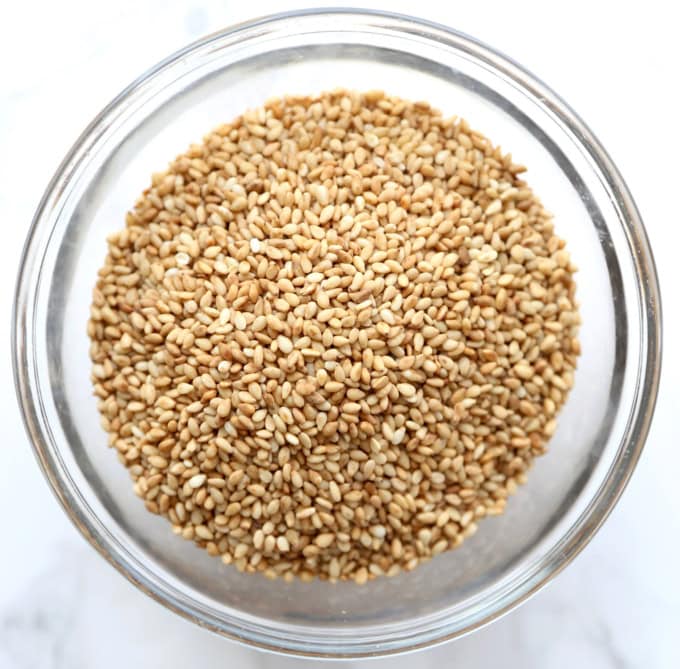
What Are Sesame Seeds?
Sesame seeds are the seeds of the sesame plant, which is the oldest oilseed crop known to man. Unlike many other crops, the sesame plant thrives in drought-like conditions. The seeds grow in pods that burst open when they are ripe. The seeds are then cleaned and their exterior coats removed.
The seeds are edible and used as an ingredient or condiment all over the world. They are also pressed for sesame oil – sesame having one of the highest oil content of any seed. The untoasted seeds are used to make tahini paste while the toasted ones can be used to make a paste similar to peanut butter.
In Japan, sesame seeds are called goma (ごま). They are found in many salads, baked snacks (sesame cookies), and sweets (sesame candy). They are also used to make condiments: gomashio, which is made from black sesame seeds and sea salt, and furikake, a mix of sesame seeds, seaweed, dried fish, sugar and salt. Even better known is kurogoma ice cream, a Japanese ice cream made from black sesame.
Used primarily in seed form and as a flavoring oil, sesame has the ability to add texture and bold, rich, nutty flavor to the dishes in which it is used. In many snacks and salads the whole seeds are used and have a pleasant, light nutty crunch.
Where Do Sesame Seeds Come From?
The sesame plant likely originated from Africa but in 2019, the largest producers were Myanmar, India and Tanzania. Major seed importers include Japan, China and Turkey.
Black Sesame Seeds VS White Sesame Seeds – What’s the Difference?
There are two main varieties: black and white sesame seeds. The black ones are unshelled while the white seeds are actually tan/brown seeds without their hull.
The presence or absence of the hull has a slight impact on taste: black seeds are crunchier and stronger in flavor whereas white seeds are milder and sweeter, and pair well with delicate dessert flavors. But the choice between the two is often more a question of appearance.
For example, choose black sesame for light-colored dishes – such as noodles – and baked goods where you want the black-on-white visual contrast. For that reason, they are also used on the rice of sushi rolls. You can also use black seeds in savory dishes that have strong spices since the mild flavor of the white seeds would disappear in those applications.
What Does Sesame Oil Taste Like?
The amber colored oil lends a distinct toasted, almost smoky element when utilized in everything from dressings, soups and sauces to stir fried dishes like nabeshigi (sautéed eggplant).
Or use a dash to add real depth to dishes like ohitashi. Use sparingly though – a little goes a long way!
How To Toast Sesame Seeds
Toasting your sesame seeds will bring out their nutlike flavor. There are two methods, each with their pros and cons.
Stovetop
This is the quickest way to do the job, but you can only toast a small amount at a time. In a dry skillet (no oil is needed) over medium heat, place an even layer of sesame seeds.
Stir with a wooden spoon or a heat-proof spatula for 3 to 5 minutes. When the seeds are golden and fragrant, remove immediately from the stove and transfer them to a plate.
Oven
Preheat the oven to 350ºF and line a baking sheet with parchment paper. Cover the parchment paper with a thin layer of sesame seeds and bake for 8 to 15 minutes, checking every 5 minutes to make sure the seeds aren’t burning.
Toss them occasionally or gently shake the baking sheet. The seeds are ready when they have turned into a light golden brown color. The the sheet out of the oven and transfer to sesame seeds to a plate. This method cooks the seeds more evenly but takes longer since you must wait for the oven to preheat, on top of the cooking time.
How to Store Sesame Seeds
Raw or toasted sesame seeds should be stored in an airtight container placed in a dry, cool and dark cupboard, or in a freezer bag if you intend on keeping them in the freezer.
How Long Do Sesame Seeds Last?
There doesn’t seem to be a consensus on how long sesame seeds last.
Depending on the source of information (or who you are asking), sesame seeds can last anywhere from 3 months, all the way up to 3 years. The important thing to know is that sesame seeds usually have a “best by” date and not an expiration date, which means they are safe to use beyond their “best by” date.
One easy way to test the freshness of sesame seeds is by rubbing a small amount of seeds in your hands: if both the aroma and the taste are weak, they won’t impart much flavor, so it’s safe to discard them.
If they smell rancid, you should definitely replace them because they will taste bad as well.
Why Are There Sesame Seeds on Buns?
Even though sesame seeds made their appearance on buns in the 1950s, we don’t know who first came up with the idea. What we know is that it was popularized by McDonald’s in 1968 when it launched its Big Mac.
But why put seeds on hamburger buns?
Since it is almost impossible they are used for flavor, some suggested it could be for texture or visual appeal. Having a better grip on your burger was another suggestion. But the truth is: it remains a complete mystery!
Recipes using sesame:














